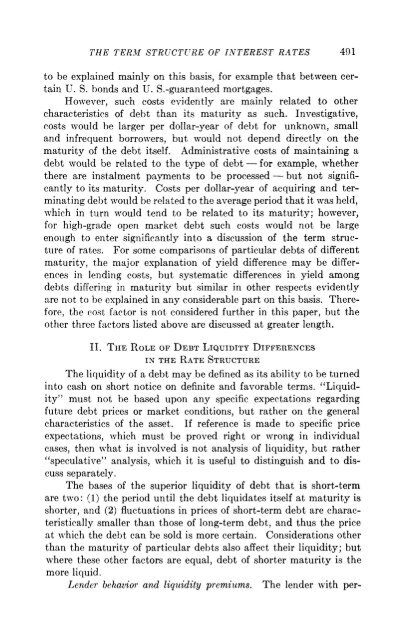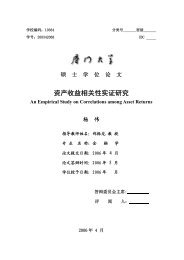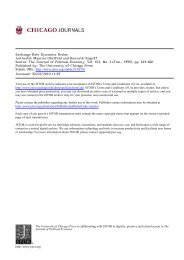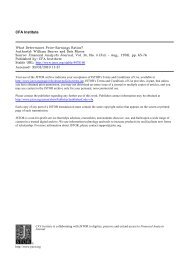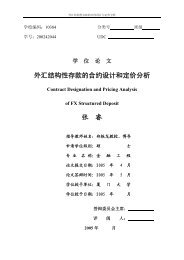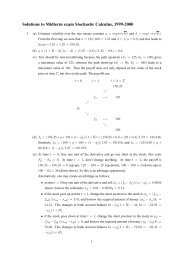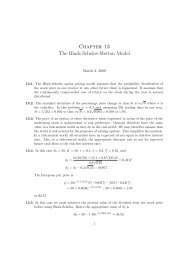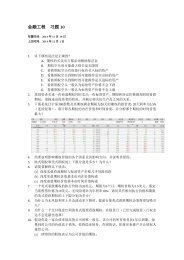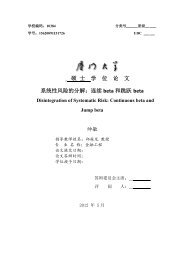The Term Structure of Interest Rates
The Term Structure of Interest Rates
The Term Structure of Interest Rates
You also want an ePaper? Increase the reach of your titles
YUMPU automatically turns print PDFs into web optimized ePapers that Google loves.
THE TERM11 STRUCTURE OF INTEREST RATES 491<br />
to be explained mainly on this basis, for example that between certain<br />
U. S. bonds and U. S.-guaranteed mortgages.<br />
However, such costs evidently are mainly related to other<br />
characteristics <strong>of</strong> debt than its maturity as such. Investigative,<br />
costs would be larger per dollar-year <strong>of</strong> debt for unknown, small<br />
and infrequent borrowers, but would not depend directly on the<br />
maturity <strong>of</strong> the debt itself. Administrative costs <strong>of</strong> maintaining a<br />
debt would be related to the type <strong>of</strong> debt - for example, whether<br />
there are instalment payments to be processed - but not significantly<br />
to its maturity. Costs per dollar-year <strong>of</strong> acquiring and terminating<br />
debt would be related to the average period that it was held,<br />
which in turn would tend to be related to its maturity; however,<br />
for high-grade open market debt such costs would not be large<br />
enough to enter significantly into a discussion <strong>of</strong> the term structure<br />
<strong>of</strong> rates. For some comparisons <strong>of</strong> particular debts <strong>of</strong> different<br />
maturity, the major explanation <strong>of</strong> yield difference may be differences<br />
in lending costs, but systematic differences in yield among<br />
debts differing in maturity but similar in other respects evidently<br />
are not to be explained in any considerable part on this basis. <strong>The</strong>refore,<br />
the cost factor is not considered further in this paper, but the<br />
other three factors listed above are discussed at greater length.<br />
II. THE ROLE OF DEBT LIQUIDITY DIFFERENCES<br />
IN THE RATE STRUCTURE<br />
<strong>The</strong>.liquidity <strong>of</strong> a debt may be defined as its ability to be turned<br />
into cash on short notice on definite and favorable terms. "Liquidity"<br />
must not be based upon any specific expectations regarding<br />
future debt prices or market conditions, but rather on the general<br />
characteristics <strong>of</strong> the asset. If reference is made to specific price<br />
expectations, which must be proved right or wrong in individual<br />
cases, then what is involved is not analysis <strong>of</strong> liquidity, but rather<br />
"speculative" analysis, which it is useful to distinguish and to discuss<br />
separately.<br />
<strong>The</strong> bases <strong>of</strong> the superior liquidity <strong>of</strong> debt that is short-term<br />
are two: (1) the period until the debt liquidates itself at maturity is<br />
shorter, and (2) fluctuations in prices <strong>of</strong> short-term debt are characteristically<br />
smaller than those <strong>of</strong> long-term debt, and thus the price<br />
at which the debt can be sold is more certain. Considerations other<br />
than the maturity <strong>of</strong> particular debts also affect their liquidity; but<br />
where these other factors are equal, debt <strong>of</strong> shorter maturity is the<br />
more liquid.<br />
Lender behavior and liquidity premiums. <strong>The</strong> lender with per-


